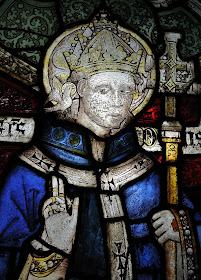When the Abbey was constructed in the early 1950's numerous reasonably priced antique pieces were acquired to furnish the main rooms, other pieces were donated by generous patrons. Among the latter acquisitions were fragments of stained glass, some rare and important. In the Abbey library, shown above, an oculus window high above the mantle was filled with a fragment of stained glass depicting Saint Dunstan.
Professor Virginia Raguin of the College of the Holy Cross came to the Abbey late last year to give us a series of presentations on the history of stained glass. As the monks were giving her a tour of the cloisters, she noticed the oculus and asked if she could inspect it in detail. Sometime later an extension ladder was set up, and Professor Raguin ascended, promising to be careful. She did her research, examining the surface of the glass and the leading, as a few of the monks watched and steadied the ladder. Professor Raguin concluded that the glass was probably of the fourteenth century, English and quite rare since much pre-Reformation glass had been destroyed during the Dissolution.
A very popular early medieval saint, Dunstan (909 –988)
was an Abbot of Glastonbury Abbey, later appointed Bishop of Manchester and London and subsequently named Archbishop of Canterbury. He is credited with the restoration of monastic life in England and the reformation of the English Church. Dunstan
was a highly skilled artist and scribe and served as an important minister of
state to several of the English kings.
As portrayed in our fragment, Saint Dunstan wears the mitre, rings, gloves and white wool pallium of his episcopal office. He carries his archbishop's cross. And the dove of the Holy Spirit perched on the apparel of his amice whispers divine inspiration. Saint Dunstan's feastday is May 19th.
Library photograph by Michel Raguin. Photographs of glass by Virginia Raguin.



